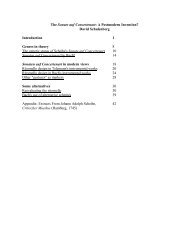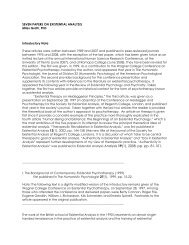download
download
download
You also want an ePaper? Increase the reach of your titles
YUMPU automatically turns print PDFs into web optimized ePapers that Google loves.
47<br />
Sources: Evaluation<br />
W. 4: Sources, p. 18<br />
W. 4 is the first concerto for which a revision (“Erneuerung”) is not listed in NV 1790.<br />
Nevertheless W. 4 underwent all of the types of revision described previously, each type of<br />
revision probably taking place in several distinct stages. For instance, the voice leading of the<br />
viola on the first two beats of ii.2 had already been revised when B1 and B2 were copied; the<br />
later reading for these two beats also appears in B3 and B6. But another alteration on the<br />
following beat of the same measure, in the same part, appears only in C1 and C2. Hence C1<br />
incorporates voice-leading revisions made on at least two separate occasions.<br />
In general, however, most revisions of a given type were probably undertaken at the same<br />
time. As a result, the groups of sources delineated below are characterized by the presence or<br />
absence of particular types of revised readings. Neither the sources nor the stages of revision can<br />
be precisely dated, but the character of the autograph entries in C1 suggests that the final stage of<br />
revision, represented by this source, could have occurred as early as the mid-1750s. This would<br />
make the latest version of W. 4 significantly earlier than the late versions of the two other<br />
concertos edited in this volume. The distinction might reflect the fact that W. 5 and 6 are larger<br />
and more challenging works, for which demand might have increased as Bach's personal style<br />
came to be more widely recognized and understood. Performances and requests for copies of<br />
such works might have grown more frequent with time, whereas demand might have diminished<br />
for a less boldly characterized piece such as W. 4.<br />
By far the greatest number of revisions were those involving the elaboration of the<br />
keyboard part, which involved numerous small changes and additions. Far more conspicuous,<br />
however, were two alterations to the formal structure of the work that took place probably at a<br />
much earlier date. These affected the ends of the last two movements: in the adagio the end of the<br />
last solo episode was altered to give the soloist an opportunity for a cadenza, and the final<br />
ritornello of the third movement was shortened. Although the early version of the third<br />
movement was thirty-two measures longer, the abbreviated later version took up more space in<br />
copies, as the final ritornello was now written out instead of being represented by a “da capo”<br />
47<br />
indication. These two formal revisions were accompanied by smaller changes especially to the<br />
inner string parts. The presence of the longer version in four independent sources leaves little<br />
doubt that it represents the composer's early version, yet three of the same sources (A1–3) also<br />
transmit alternate performance markings of uncertain origin, discussed below.<br />
Source groups<br />
The sources fall into three main groups, designated by the letters A, B, and C:<br />
A: sources preserving the earliest readings (sources A1–4);<br />
B: sources containing formal revisions of movements 2 and 3 as well as changes of detail<br />
primarily in the string parts (sources B1–7);<br />
C: sources containing the above revisions as well as ornamentation, embellishment, and<br />
variation of the keyboard part (sources C1–2).<br />
The revised final ritornello is equivalent to mm. 23–6 + 37–44; there is a corresponding revision of the<br />
keyboard in iii.186.















